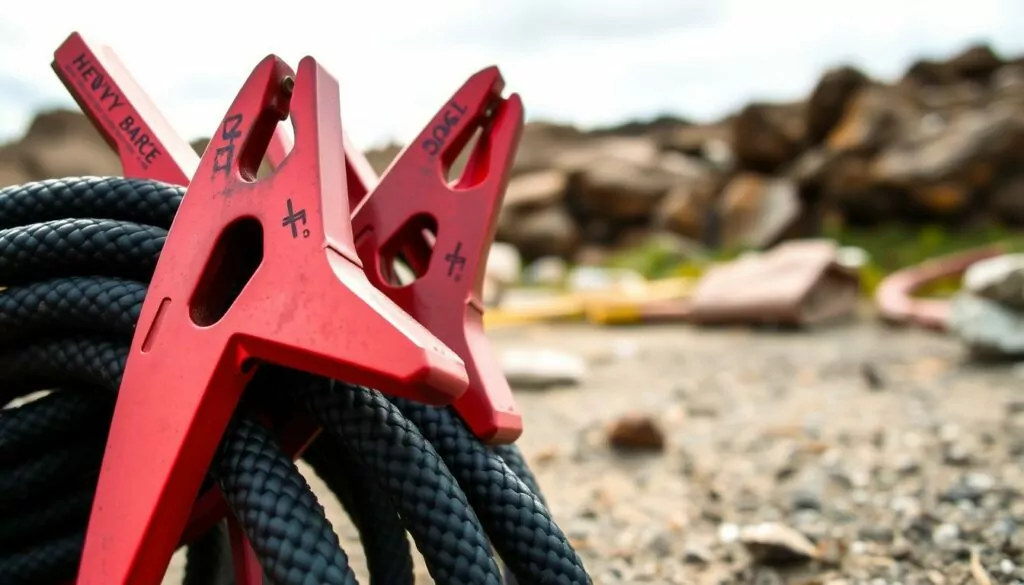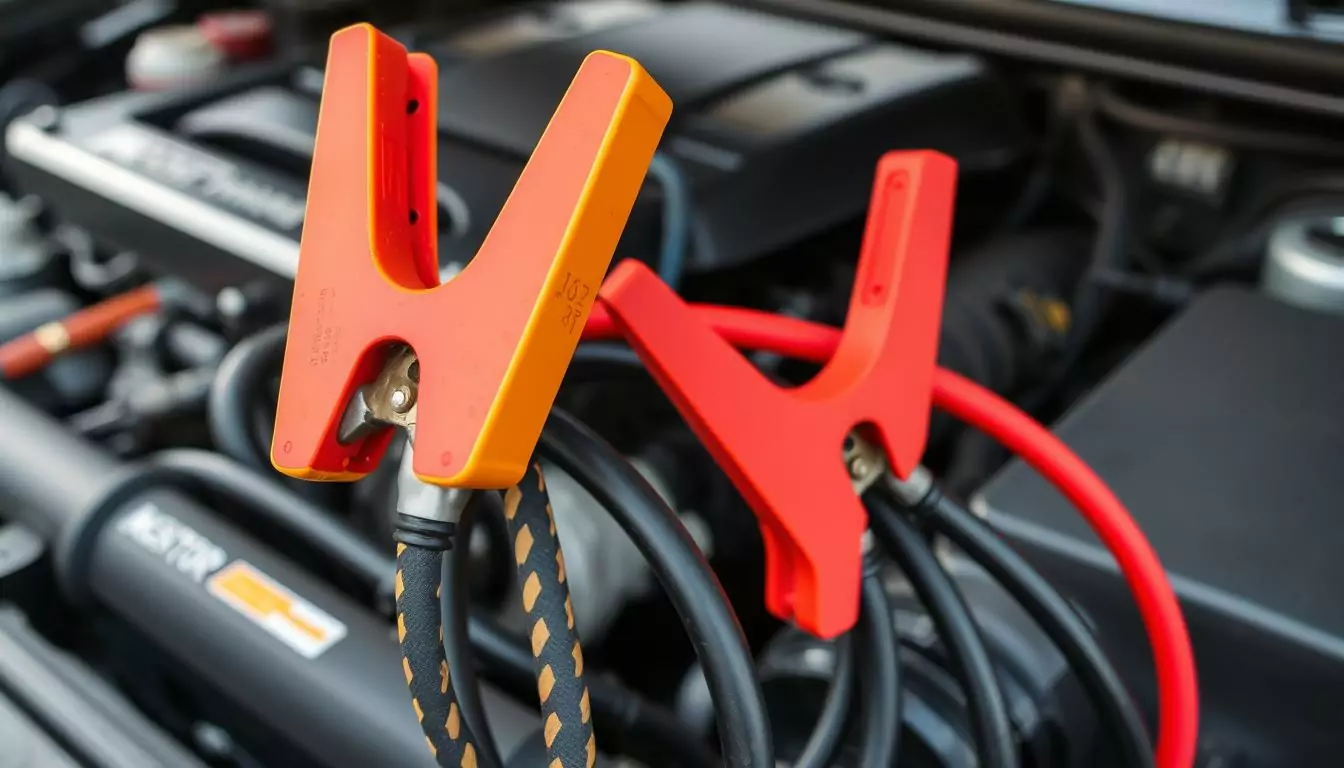Picture this: You’re shivering in a freezing parking lot, your breath fogging up the air, and your car just won’t start. Ugh, I’ve definitely been there! One brutal winter night, I was stranded, totally kicking myself for not having decent jumper cables. Let’s just say I learned my lesson the hard way—always be ready for a car emergency, especially a dead car battery!
Quality heavy-duty jumper cables aren’t just some random gear you toss in your trunk. Seriously, they’re your lifeline when your battery decides to take an unexpected nap. Whether it’s icy weather, leaving your lights on, or just a worn-out battery giving up, the right cables can turn a potential nightmare into a quick fix. Ready to find the perfect set and get some peace of mind? Let’s dive in!
Why You Absolutely Need Heavy-Duty Jumper Cables in Your Car
Think of heavy-duty jumper cables (or heavy duty booster cables, same thing!) as your roadside superhero cape. They aren’t just an accessory—they’re a non-negotiable part of your emergency kit. Investing in solid battery booster cables is like buying an insurance policy for your travels. You hope you’ll never need them, but when that moment hits – like dealing with dead batteries – you’ll be incredibly thankful they’re tucked away in your trunk. Trust me, I’d much rather have them and not need them than need them and not have them!
- Quick Rescue: Get your car running again fast—no more waiting ages for a tow truck or roadside assistance when you have flat batteries.
- Safety First: Good cables have thick insulation and tough clamps designed to prevent scary sparks and shorts during the jump-start process.
- Wallet-Friendly: A one-time purchase beats paying for pricey roadside service calls every time your battery drain gets the best of you.

Jumper Cable Basics: What Makes a Great Set?
Cable Gauge (AWG): Thicker is Definitely Better!
Does the thickness of the cable really matter? You bet it does! The “gauge” (often shown as AWG) tells you how thick the wire is and how much electrical current (amps) it can safely handle. Here’s the trick: lower gauge numbers mean thicker cables, which means more power delivery – essential for reaching the necessary Peak Amp to start a stubborn engine. Got a big vehicle like a truck or SUV? You’ll want heavy-duty truck jumper cables, typically 1-4 gauge. Driving a standard sedan? 6-8 gauge booster cables are usually perfect. Smaller compact cars? You can probably get away with 10-12 gauge. Pretty simple, right?
| Gauge (AWG) | Typical Amperage | Best Vehicle Type |
|---|---|---|
| 1-4 | 400-600A+ | Trucks, SUVs, Large Vehicles (Needs high Peak Amp) |
| 6-8 | 300-400A | Sedans, Full-size Cars |
| 10-12 | 200-300A | Compact Cars |
Cable Length: Go Long, Seriously!
Here’s a pro tip born from my own frustrating experiences—longer cables are a total lifesaver! Aim for *at least* 20 feet if you can. This gives you plenty of wiggle room to connect the car with the dead battery to the donor battery, even if you’re parked nose-to-tail, side-by-side in a tight spot, or just awkwardly far apart. Flexibility is also key. Trying to wrestle with stiff, cheap cables in the cold? It’s a real pain—believe me, I’ve lived it!
Clamps: It’s All About the Grip!
Don’t overlook the clamps – they’re the crucial connection point delivering the juice! Don’t skimp here. Look for heavy-duty clamps, preferably made of copper or copper-plated, with strong springs and jagged teeth. A solid, secure grip on the battery terminals (and the ground point) is essential for efficient power transfer. This ensures your car starts smoothly and reduces the risk of the clamps slipping off mid-jump.

My Go-To Heavy-Duty Jumper Cables
Okay, confession time: I’ve tested a *lot* of jumper cables over the years. My garage kind of looks like a cable museum! After plenty of real-world use (sometimes planned, sometimes not!), here are a few reliable sets I often recommend. Keep in mind, the best choice depends on your vehicle and needs. (And hey, maybe check out some Project Farm videos for hardcore testing!)
| Cable Brand | Length | Gauge | Ideal Vehicle Type |
|---|---|---|---|
| EverStart Jumper Cables | 16 feet | 6-gauge (Copper-Clad Aluminum) | Sedans & Compact Cars |
| NOCO Boost XL Cables | 25 feet | 4-gauge (Pure Copper) | SUVs & Trucks (Consider their Noco Jump starters too!) |
| Cartman Booster Cables | 12-25 feet options | 4 to 8-gauge options | SUVs & Light Trucks |
For smaller cars, those EverStart cables are often a great balance of performance and price – they’re flexible and easy to handle. Got a beefier ride like a truck or large SUV needing serious amps? The pure copper wiring in something like the NOCO Boost XL is hard to beat – it provides excellent conductivity. If you like having options, Cartman offers various lengths and gauges, often with comfy grips, making them a solid choice too. You can sometimes find decent budget options at places like Harbor Freight, just be sure to check the specs match your needs!
How to Jump-Start Your Car Safely (The Spark-Free Way!)
Safety is my absolute number one priority when jump-starting! Before you even think about connecting cables, grab some gloves and safety glasses if you have them. It’s rare, but batteries can sometimes release flammable gases. Here’s my step-by-step, no-sparks guide:
- Positive (+) to Dead (+): Clip one end of the RED (+) cable to the positive (+) terminal of the dead car battery.
- Positive (+) to Donor (+): Clip the other end of the RED (+) cable to the positive (+) terminal of the good battery (the donor battery).
- Negative (-) to Donor (-): Clip one end of the BLACK (-) cable to the negative (-) terminal of the good battery.
- Negative (-) to Ground: Now, here’s the crucial part for safety! Clip the OTHER end of the BLACK (-) cable to an unpainted metal surface on the car with the dead battery. Choose a spot on the engine block or chassis, *away* from the battery itself. This grounds the circuit safely.
- Start the Engines: Start the engine of the car with the good battery and let it run for a few minutes. Then, try starting the car with the dead battery.
- Disconnect Carefully: Once the dead car starts, remove the cables in the REVERSE order you connected them: Black from ground, Black from donor battery, Red from donor battery, Red from dead battery.
Don’t let the cars sit connected for an excessive amount of time after the disabled car starts – just long enough to get it running smoothly on its own!
Video Guide: Watch How to Jump-Start Like a Pro
Sometimes seeing it done makes all the difference. Check out this helpful video:

Keep Your Cables Ready: A Quick Road Safety Checklist
- Inspect Regularly: Give your heavy duty jumper cables a quick look-over every few months. Check for cracked insulation, frayed wires, or damaged clamps.
- Store Them Right: Coil the cables loosely (don’t kink them!) and store them in a cool, dry place, like the bag they came in, tucked away in your trunk.
- Battery Health Matters: Remember, jumper cables are a temporary fix. Pay attention to your car’s battery life. If it’s old or constantly needing jumps, it might be time for a replacement battery. Consider getting your battery and charging system tested.
Ready to Grab Your Own Set of Lifesaving Jumper Cables?
Whew! Hopefully, this guide makes choosing the right jumper cables heavy duty enough for your needs feel way less daunting. It really boils down to being prepared for those unexpected roadside hiccups. Like the old saying goes – better safe than sorry, right? So, have you checked your trunk lately? Are you equipped for a potential battery dead situation?
Jumper Cable FAQs: Your Quick Questions Answered
Can I just use regular, thinner jumper cables instead of heavy-duty ones?
You *can*, but it’s often not ideal. Heavy-duty booster cables handle more power (higher Peak Amp) more efficiently and safely. They’re much better, especially in cold weather or when jump-starting larger vehicles like trucks that need more juice. Thinner cables can overheat or fail to deliver enough power.
How long do jumper cables typically last?
If you treat them well (store them properly, avoid damage) and give them an occasional inspection, a good quality set of heavy-duty cables can easily last 5-10 years, sometimes even longer!
What’s more important: the cable gauge or the length?
Honestly, both are really important! Gauge determines the power capacity (thicker is better for more power), while length provides the practical flexibility to reach between vehicles. You need a good balance of both for an effective and convenient set of cables.
Can I use standard jumper cables to jump-start an electric vehicle (EV)?
Nope, definitely not! EVs have complex high-voltage systems. Trying to jump-start an EV’s main traction battery with standard 12V jumper cables is dangerous and won’t work. They require specialized procedures and equipment if their 12V auxiliary battery (which powers accessories) is dead.
Should I get pure copper or copper-clad aluminum (CCA) cables?
Pure copper offers the best electrical conductivity, making it the premium choice, especially for very heavy-duty applications (like truck jumper cables). However, it’s also more expensive. Copper-Clad Aluminum (CCA) is a more budget-friendly option where an aluminum core is coated with copper. CCA cables work well for most standard car and light truck applications and offer a good compromise between cost and performance. Check the gauge – a thicker CCA cable can often perform similarly to a slightly thinner pure copper one. Watch out for the difference in price when comparing.
What about a portable battery jump starter instead of cables?
Great question! A portable battery jump starter (often a lithium Ion jump starter or battery pack) is another excellent option. These devices contain their own internal battery (like a lithium battery or sometimes a small lead-acid battery) and don’t require a second vehicle (a donor battery). They offer plenty of power in a compact form, often include extra features like USB ports to act as a Power Bank for cell chargers, and a built-in LED light. Popular options include the Noco GBX series or models from GOOLOO. Some people prefer the simplicity of cables, while others love the self-sufficiency of a portable power source like a jump starter power pack. It depends on your preference and budget!
